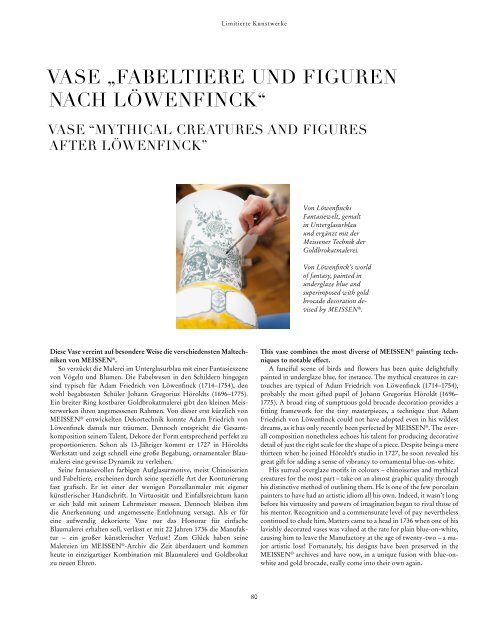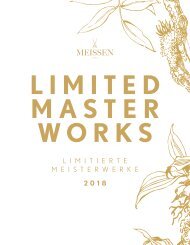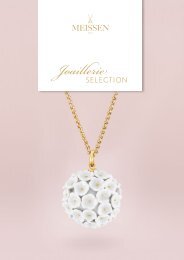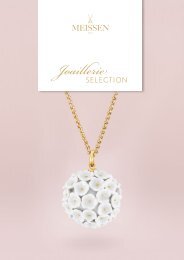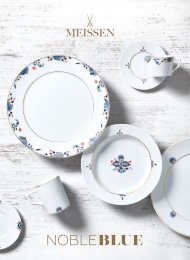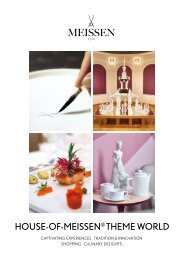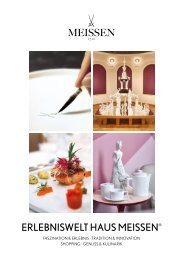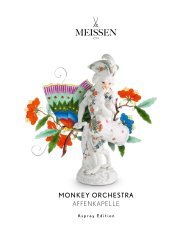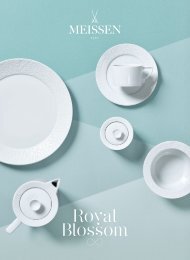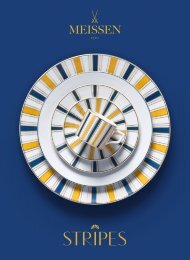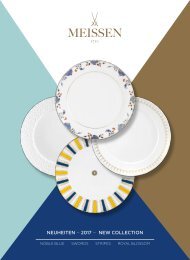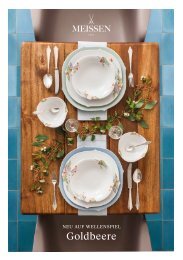MEISSEN LIMITIERTE KUNSTWERKE 2014
Kunst und Können, Ausdauer und Arbeitswillen, Liebe zum Detail und Leidenschaft für ein jahrhundertealtes Kunsthandwerk – all das müssen die Künstler von MEISSEN® mitbringen, um aus edlem Porzellan kostbare Sammlerstücke für die Ewigkeit zu erschaffen. --- Art and ability, endeavour and endurance, loving attention to detail and a passion for centuries-old works of art – these are just some of the attributes that MEISSEN® artists require in order to create priceless collector’s items in porcelain for posterity.
Kunst und Können, Ausdauer und Arbeitswillen, Liebe zum Detail und Leidenschaft für ein jahrhundertealtes Kunsthandwerk – all das müssen die Künstler von MEISSEN® mitbringen, um aus edlem Porzellan kostbare Sammlerstücke für die Ewigkeit zu erschaffen.
---
Art and ability, endeavour and endurance, loving attention to detail and a passion for centuries-old works of art – these are just some of the attributes that MEISSEN® artists require in order to create priceless collector’s items in porcelain for posterity.
Sie wollen auch ein ePaper? Erhöhen Sie die Reichweite Ihrer Titel.
YUMPU macht aus Druck-PDFs automatisch weboptimierte ePaper, die Google liebt.
Limitierte Kunstwerke<br />
VASE „FABELTIERE UND FIGUREN<br />
NACH LÖWENFINCK“<br />
VASE “MYTHICAL CREATURES AND FIGURES<br />
AFTER LÖWENFINCK”<br />
Von Löwenfincks<br />
Fantasiewelt, gemalt<br />
in Unterglasurblau<br />
und ergänzt mit der<br />
Meissener Technik der<br />
Goldbrokatmalerei.<br />
Von Löwenfinck’s world<br />
of fantasy, painted in<br />
underglaze blue and<br />
superimposed with gold<br />
brocade decoration devised<br />
by <strong>MEISSEN</strong> ® .<br />
Diese Vase vereint auf besondere Weise die verschiedensten Maltechniken<br />
von <strong>MEISSEN</strong> ® .<br />
So verzückt die Malerei im Unterglasurblau mit einer Fantasieszene<br />
von Vögeln und Blumen. Die Fabelwesen in den Schildern hingegen<br />
sind typisch für Adam Friedrich von Löwenfinck (1714–1754), den<br />
wohl begabtesten Schüler Johann Gregorius Höroldts (1696–1775).<br />
Ein breiter Ring kostbarer Goldbrokatmalerei gibt den kleinen Meisterwerken<br />
ihren angemessenen Rahmen. Von dieser erst kürzlich von<br />
<strong>MEISSEN</strong> ® entwickelten Dekortechnik konnte Adam Friedrich von<br />
Löwenfinck damals nur träumen. Dennoch entspricht die Gesamtkomposition<br />
seinem Talent, Dekore der Form entsprechend perfekt zu<br />
proportionieren. Schon als 13-Jähriger kommt er 1727 in Höroldts<br />
Werkstatt und zeigt schnell eine große Begabung, ornamentaler Blaumalerei<br />
eine gewisse Dynamik zu verleihen.<br />
Seine fantasievollen farbigen Aufglasurmotive, meist Chinoiserien<br />
und Fabeltiere, erscheinen durch seine spezielle Art der Konturierung<br />
fast grafisch. Er ist einer der wenigen Porzellanmaler mit eigener<br />
künstlerischer Handschrift. In Virtuosität und Einfallsreichtum kann<br />
er sich bald mit seinem Lehrmeister messen. Dennoch bleiben ihm<br />
die Anerkennung und angemessene Entlohnung versagt. Als er für<br />
eine aufwendig dekorierte Vase nur das Honorar für einfache<br />
Blaumalerei erhalten soll, verlässt er mit 22 Jahren 1736 die Manufaktur<br />
– ein großer künstlerischer Verlust! Zum Glück haben seine<br />
Malereien im <strong>MEISSEN</strong> ® -Archiv die Zeit überdauert und kommen<br />
heute in einzigartiger Kombination mit Blaumalerei und Goldbrokat<br />
zu neuen Ehren.<br />
This vase combines the most diverse of <strong>MEISSEN</strong> ® painting techniques<br />
to notable effect.<br />
A fanciful scene of birds and flowers has been quite delightfully<br />
painted in underglaze blue, for instance. The mythical creatures in cartouches<br />
are typical of Adam Friedrich von Löwenfinck (1714–1754),<br />
probably the most gifted pupil of Johann Gregorius Höroldt (1696–<br />
1775). A broad ring of sumptuous gold brocade decoration provides a<br />
fitting framework for the tiny masterpieces, a technique that Adam<br />
Friedrich von Löwenfinck could not have adopted even in his wildest<br />
dreams, as it has only recently been perfected by <strong>MEISSEN</strong> ® . The overall<br />
composition nonetheless echoes his talent for producing decorative<br />
detail of just the right scale for the shape of a piece. Despite being a mere<br />
thirteen when he joined Höroldt’s studio in 1727, he soon revealed his<br />
great gift for adding a sense of vibrancy to ornamental blue-on-white.<br />
His surreal overglaze motifs in colours – chinoiseries and mythical<br />
creatures for the most part – take on an almost graphic quality through<br />
his distinctive method of outlining them. He is one of the few porcelain<br />
painters to have had an artistic idiom all his own. Indeed, it wasn’t long<br />
before his virtuosity and powers of imagination began to rival those of<br />
his mentor. Recognition and a commensurate level of pay nevertheless<br />
continued to elude him. Matters came to a head in 1736 when one of his<br />
lavishly decorated vases was valued at the rate for plain blue-on-white,<br />
causing him to leave the Manufactory at the age of twenty-two – a major<br />
artistic loss! Fortunately, his designs have been preserved in the<br />
<strong>MEISSEN</strong> ® archives and have now, in a unique fusion with blue-onwhite<br />
and gold brocade, really come into their own again.<br />
80


